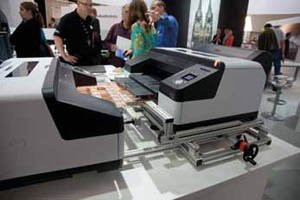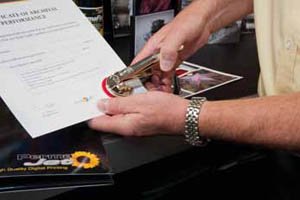articles/Review/photokina2012-page6
Photokina 2012 - part 6 of 1 2 3 4 5 6 7
by Mike McNamee Published 01/10/2012

Whereas lenses are sometimes referred to as the camera's 'eyes', the viewfinder and the display are its glasses, which depict the image in a more or less brilliant and lifelike manner. In the latest generation of cameras, optical viewfinders are increasingly being displaced by electronic ones. The advantage of electronic viewfinders is that they depict the image exactly as the sensor currently 'sees' it under the current exposure settings and show how it will be seen on the display after the shutter has been released. A few years ago, it was still considered a major technological achievement that cameras could be activated and automatically focused simply by looking through the viewfinder. Now, however, this feature is increasingly becoming standard equipment. Many cameras now activate the electronic viewfinder as soon as a user moves the camera to his or her eye. And thanks to the use of OLED technology, the display quality is once again greatly enhanced with regard to resolution and colour saturation. The high-resolution folding displays can increasingly be used for manual viewfinding. Many of the displays can now be folded up or turned forward so that they can be used to check the angle of the image when making self-portraits or taking group pictures in which the photographer wants to appear as well. The use of this technology, in which the display can be 'seen' through a conventionally placed viewfinder gets around the need to hold a camera away from the stabilising location close to the face and eye. It also allows for a 'Live View', but with no mirror, the lens design is freed of constraints, for example inverted telephoto designs of wide angle lenes are not required as there is no mirror box to clear. The lack of a mirror clattering up and down will also be beneficial for vibration reduction and in particular for macro and microscopic photography.

CGI
CGI was a main theme of photokina 2012 and we took the time to gather as much information as possible and form new links with the shakers and movers in the field. Opportunities abound for photographers with good background technical skills and content-providers such as moofe (www.moofe .com) were on the prowl for international photographers who can join them and add content to their resource-based venture. We also spent time with Spheron, discussing their 360 degree camera/software system, vital for the creation of the scenic data used to 'light' and impose relections and shadows on a CGI 'model' placed into a scene.
Please Note:
There is more than one page for this Article.
You are currently on page 6
- Photokina 2012 page 1
- Photokina 2012 page 2
- Photokina 2012 page 3
- Photokina 2012 page 4
- Photokina 2012 page 5
- Photokina 2012 page 6
- Photokina 2012 page 7
1st Published 01/10/2012
last update 09/12/2022 14:57:44
More Review Articles
There are 0 days to get ready for The Society of Photographers Convention and Trade Show at The Novotel London West, Hammersmith ...
which starts on Wednesday 15th January 2025





